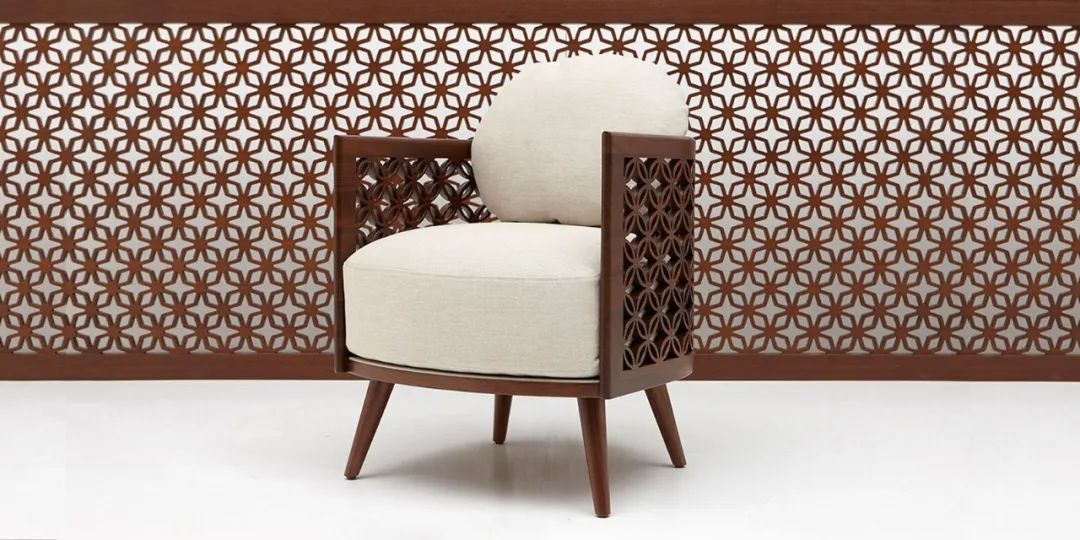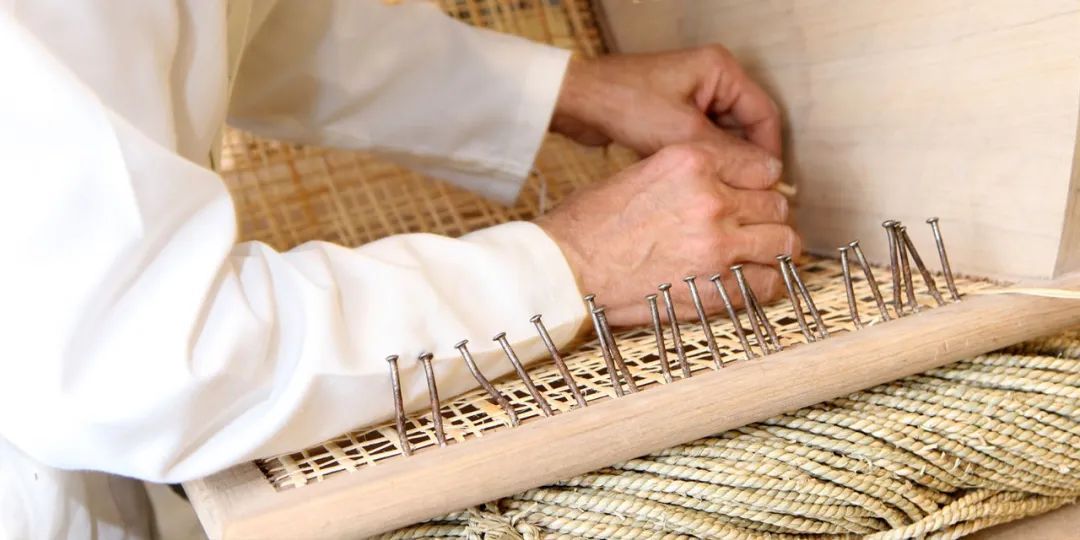Unveiling Mastery: Nada Debs and the Timeless Quest to Perfect Craftsmanship
)
After returning to Lebanon, Nada Debs felt a deeper sense of belonging and identity. She dedicated herself wholeheartedly to design, deeply influenced by Middle Eastern culture. Take, for example, the Dervish Carafe, whose design inspiration stems from a 13th-century religious meditation ritual. In this ritual, monks continuously spin and twirl while meditating deeply, their robes forming swirling lines – elements that Nada skillfully incorporates into the patterns adorning the glass carafe.
As a melting pot of Eastern and Western cultures, Lebanon has long been immersed in an aesthetic storm. Influenced by its history of French colonization, it earned the moniker "Paris of the East," until the Beirut blast of 2020.
Walnut veneer tissue boxes priced at $400, glass carafes at $350, and furniture pieces like the "Love Triangle" wool rug, "Mother of Pearl Table," and "Tatami Table" – some without listed prices – all grace the shelves of designer Nada Debs' online storefront. In our conversation with Nada Debs, she shared insights into her style: "This is my creation of 'neo-Arabian' style. Faced with a traditional handicraft, I rework its lines, subtracting and adding new materials to render it modern because I specialize in minimalist furniture."

In a sense, Lebanese-born Nada Debs can be considered a "neo-Arabian" herself. Though not native to Lebanon, decades of work and life have exposed her to various cultures globally. Born in Kobe, Japan, she studied design at the Rhode Island School of Design in the USA and worked in the UK before establishing studios in Dubai and Beirut, occasionally returning to Japan to visit her mother. "I come from a multicultural environment, surrounded by Americans, Europeans, Chinese, Koreans, and Japanese," Nada remarked. Perhaps this exposure enabled her to imbue her designs with a universal language, gradually finding geometric patterns as a common ground.

"My personal style is very minimalist," Nada said, "but I also love complexity." Indeed, geometric patterns can possess both attributes. Dating back to around 3000 BCE, geometry emerged. The term "geometry" derives from Greek, with "geo" meaning "earth" and "metron" meaning "measure." Geometry encompasses everything, as American theoretical physicist Antony Garrett Lisi once said, "The universe is pure geometry—a beautiful shape twisting and dancing in spacetime."

Throughout history, in the Arab world, geometry has not only been mathematical but also frequently adorns the walls of buildings. Islamic geometric patterns are composed of four basic shapes: circles, squares, pentagrams, and polygons. They overlap and intertwine on structures, forming intricate patterns, often associated with the religious attributes of "infinity" and "eternity." As various cultures collided in Nada's mind, sparks ignited her inspiration to utilize geometric patterns to express their cultural essence. Thus, geometric patterns became a crucial anchor for Nada in her quest for belonging.
Nada pays close attention to detail, constantly seeking a balance between simplicity and complexity, which is the unique charm of her design universe. Influenced by traditional Japanese aesthetics from her childhood, she absorbs elements of aesthetics from every culture she encounters. "I'm always looking for the essence of things. When I see many crafts, I think about what this craft is about? What is its essence made of?" After coming to Lebanon, she delved into the local handicraft scene, personally visiting workshops to understand traditional crafts, witnessing many intricate Ottoman-style furniture pieces. While many believe that crafts should become more complex over time, Nada decided to present traditional craftsmanship in a minimalist way. She told us, "I always say to the craftsmen, 'Can you remove this? Keep only a circle or square so that the craftsmanship itself stands out.'"

Indeed, craftsmanship is closely related to "luxury" and provides rationality for Nada's products' premium pricing. For centuries, the Middle East has been a hub for global textile trade, playing a crucial role in the Silk Road trade route, becoming a vital nexus for handmade crafts. However, with the advent of standardized production in the 20th century, craftsmanship gradually gave way to machines, and the surviving crafts acquired the characteristic of being "rare and precious." Consequently, the Middle East became a crucible for brands and craftsmen who adhere to the idea of heritage preservation in everything they do.
Inlay craftsmanship is often used in Nada's works. Inlay is a decorative technique where craftsmen often involve cutting and assembling different wood veneers on the panels of furniture to create patterns on the surface. For example, in Nada's works, the pattern of the "Tatami Table" resembles a typical Japanese floor, using traditional weaving techniques supplemented with ancient inlay craftsmanship, complemented by modern Japanese gradient colors, perfectly interpreting the fusion of Eastern and Western aesthetics. During the interview, Nada showed us a sample board with pearl inlay in walnut veneer. When we asked how long it would take to complete, Nada jokingly remarked, "It takes forever."
After returning to Lebanon, Nada felt a deeper sense of belonging and identity, devoting herself wholeheartedly to design, deeply influenced by Middle Eastern culture. Take the Dervish Carafe, for example, whose design inspiration stems from a 13th-century religious meditation ritual. In this ritual, monks continuously spin and twirl while meditating deeply, their robes forming swirling lines – elements that Nada skillfully incorporates into the patterns adorning the glass carafe.

As a melting pot of Eastern and Western cultures, Lebanon has long been immersed in an aesthetic storm, influenced by its history of French colonization. It earned the moniker "Paris of the East." The history of Lebanese design can be traced back to the French colonial period (1918-1943), during which Beirut was declared the capital of Greater Lebanon in 1920 and underwent restructuring in accordance with Western models, experiencing significant commercial development. After the end of the civil war in 1990, the reconstruction of Beirut became a top priority, prompting many Lebanese citizens to return home, and the design field began to reclaim geographical, economic, and creative space against this backdrop. Beirut gradually became a creative hub, with design studios, galleries, architectural firms, and dining and entertainment venues settling in. Nada also chose to return to Lebanon in 1999. It is worth mentioning that Elie Saab and Zuhair Murad are globally recognized Lebanese haute couture brands. Some people commented, "With gorgeous beadwork, flowing light skirts, intricate embroidery, and vivid colors concentrated on the same dress, you can guess blindly that it's the work of Lebanese designers." Hence, the warm and colorful palette in Nada's works is also a continuation of the aesthetic of Lebanese design.
However, life is unpredictable. The Beirut blast of 2020 prompted her to contemplate more profound issues. The explosion claimed nearly 200 lives, injured over 6,000 people, and left 300,000 homeless. "At that time, we were worried about the future of Lebanon, so I decided to expand and open a second studio in Dubai." Indeed, Dubai has provided Nada's career with a broader horizon. "It was a wise choice, and the studio in Dubai has brought us opportunities to collaborate with major brands and European brands."
The business world remains challenging. Nada, who comes from a design background, admits that she is not good at "being a good boss." "I have plenty of ideas in my head, but conveying them to a team of twenty isn't an easy task." Nowadays, Nada still frequently travels the world, drawing inspiration from various cultures. She delves deep into impoverished areas, collaborating with marginalized artisans, committed to preserving traditional craftsmanship. "We act as guardians of handicrafts, ensuring skills aren't lost," she affirms. She expresses hopes to continue melding different cultures through design, particularly mentioning her anticipation for collaborating with Chinese artisans. "Collaborating with Chinese artisans would be incredible for me. Blending two cultures, creating a new one holds significant meaning for me. We must evolve continually, not stagnate in the past."
Geometric patterns remain Nada's current focus. She's delved into embroidery work, especially straw weaving. "Our latest series is called 'Bespoke Couture,' as it feels like crafting haute couture on furniture, employing similar methods. But I enjoy using more organic materials, employing very soft lines. It's an intriguing direction we're exploring this year."
Currently, artificial intelligence has made her realize the importance of keeping pace with the times. However, she candidly admits being the "antithesis of AI" – while AI is computer-generated, she focuses on manual craftsmanship. Hence, she's still searching for ways to evolve alongside AI. She confesses, "I'm seeking answers because I understand I can't solely focus on craftsmanship. I must find a way to adapt to AI, but I haven't found it yet." Whenever Nada's answers emerge, we have every reason to believe AI won't halt her stride. Her curiosity and creativity will undoubtedly continue bridging cultures worldwide, presenting a unique charm of "Neo-Arabian" allure.


